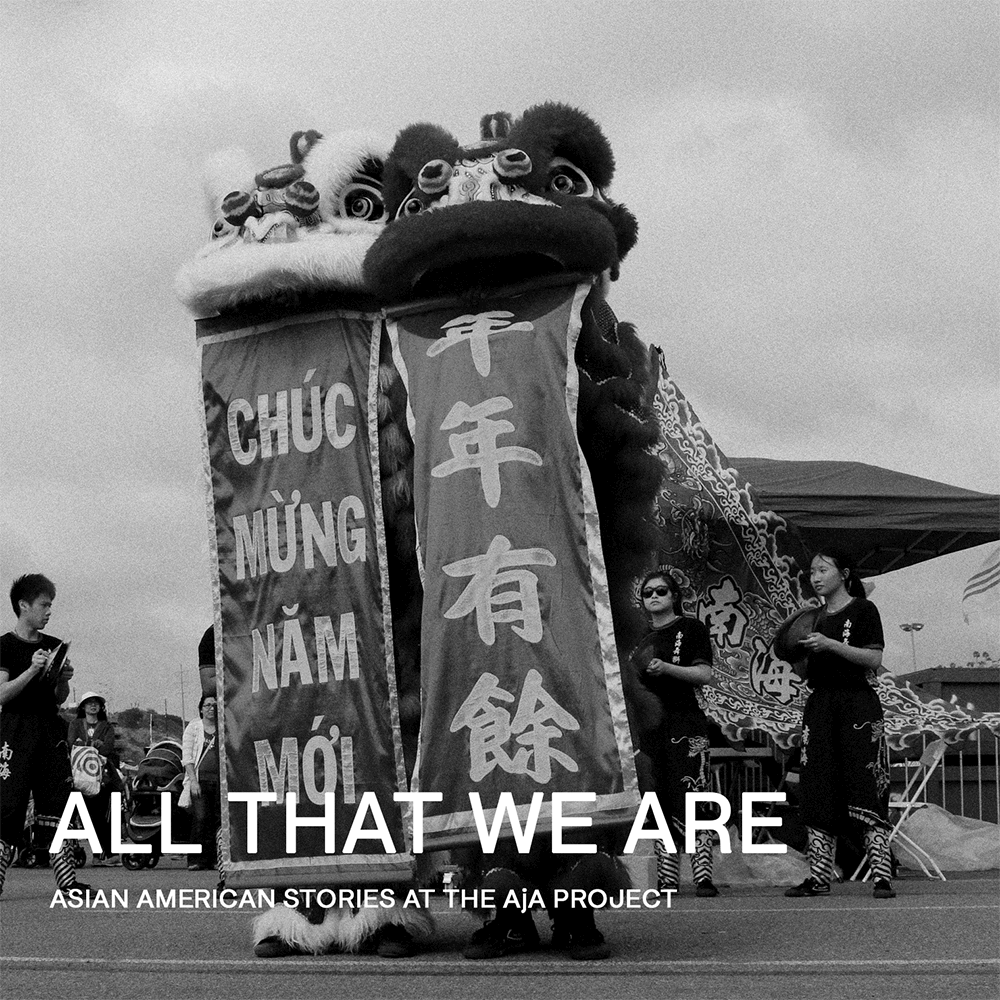
ALL THAT WE ARE
A month-long celebration of the multidimensional lives of Asian Americans in relationship to The AjA Project
ALL THAT WE ARE is an archive of the multidimensional lives of Asian Americans in relationship to our work at the AjA Project. Throughout April 2021, we featured a curated selection of creative works on social media —including films, photos, and artist talks— from Asian American programming with ties to local stories and community.

HOW CAN WE TELL OUR STORIES IN WAYS THAT HONOR ALL PARTS OF OURSELVES?
This month, we invite you in asking:
How can we tell our stories in ways that confront the parts of us that are hard to talk about or face? The ones that are complicated, beautiful, conflicting, difficult, erased, loved, and seen? How do our stories and struggles interconnect, contradict, challenge each other, mend harm, and converge?
Join us in unpacking the Balikbayan boxes in our lives, revisiting past work, reflecting on where more work must be done, and celebrating the many parts that make up who we are throughout April 2021.
Original photo by Famo Musa
“I AM LOOKING AT EXACTLY WHAT MAKES ME DIFFERENT FROM THOSE WHO CAME BEFORE ME AND ALSO HOW I AM STILL SHAPED BY THEM.”
Kristi Lin & AjA’s Civil Liberties Project
Kristi's beautiful exhibition, “Borrowed Scenery,” is a historic moment in the history of the Japanese Friendship Garden– there have been very little opportunities for public installations, and Borrowed Scenery is one of the first to be able to take up this space.
The exhibition interweaves both hand dyed clothes and heritage, memory, and landscape, drawing from Kristi’s background as a 4th generation Japanese American and 3rd generation Chinese American.
On her process for creating the exhibition, Kristi shared:
“I see two approaches. One approach that I see is to try to preserve the past… This preservation approach seems to temporarily remedy the nostalgia and desire to put things back where they used to be. The alternate approach is to acknowledge that things will never be the same… I am looking at exactly what makes me different from those who came before me and also how I am still shaped by them. By using my own imagination to create art inspired by the history, I am using myself as a test subject for understanding how my generation is transforming our culture.”
Borrowed Scenery explores Kristi’s 4th generation Japanese American and 3rd generation Chinese American identity through the garden design technique of 借景 shakkei (Japanese) and jièjǐng (Chinese), which both translate to “borrowed scenery.” Whereas historically, a garden designer would take a distant view, such as a faraway mountain, and incorporate, or “borrow,” it into the garden composition, Kristi borrows the Japanese Friendship Garden into her large woven installation.
———
Kristi’s work was created as part of AjA’s Civil Liberties Project, a competitive fellowship that interrogates historic violations of civil liberties, including Japanese American incarceration, and their connections to our present day communities through archives, readings, discussions, and creative work. See more of Kristi’s work @kristimlin.art.
Footage by Beto Soto. Edited by Winter Smiley.

What is our relationship to the archive and Japanese Internment? How do these experiences bridge with our personal history?
Civil Liberties Fellows worked with Teaching Artists dana washington-queen and Luisa Martínez to explore and experiment with art forms as a way to interrogate history.
Though the AjA Project’s Civil Liberties Fellowship, the cohort considered the archive as a generative space and together ideate alternative archiving models and socio-historical art practices. 2019-2020 Fellows Natalia Quintero, Kristi Lin, and Famo Muso built upon personal explorations to create a multimedia online archive and corresponding public interventions that invite audiences to engage with community histories.
Generously funded by the California State Library. Original photo of work by Famo Musa; shot by Beto Soto.










HOW CAN WE SUPPORT YOUTH WHOSE BORDER IS MADE INVISIBLE BY THE SEA?
WHOSE STORIES ARE SHAPED BUT NOT DEFINED BY WAR?
PHOTOS BY
AMI IKEDA
JOSEPH HAQUANG
CARTER DUONG
THUY TRANG SABRINA PHAM-VU
THY MAI
CATHERINE NGUYEN
Little Saigon Stories is a multimedia project that documents the stories of local Vietnamese refugees and their descendants who have lived and worked in San Diego’s Little Saigon District, on El Cajon Boulevard, since the 1970s.
It was facilitated by the Media Arts Center San Diego in collaboration with the AjA Project, Little Saigon Foundation, and El Cajon Boulevard Business Improvement Association, and was made possibly by generous support from the California Institute of the Humanities, National Endowment for the Arts, LISC San Diego, City of San Diego, and the California Arts Council.
Voice in Video: AjA Managing Director Rizzhel Javier

HYPERLOCAL VISIONS

Interweaving our stories…
HYPERLOCAL VISIONS was a guest speaker series where two photographers were paired together to compare and contrast their work in relationship to community. A public, live Q&A session with each artist pairing was hosted every Wednesday at 6pm PST, from October 28th to November 25th, 2020.
Local photographers Johnny Nguyen and Ian Cuevas joined each other in the third installment of the Hyperlocal Visions series to explore how their use of candid street photography can be an exercise in trust. The two dived deep into the ethics of photography as a form of activism and how to tap into creative spirit amidst a global pandemic.
Through their conversation, we’re left to wonder: how can photo nourish our spirt, our stories, and our struggles? How can photography connect the stories of complete strangers?
Closing off the series were friends and artists Melissa Dueñas and Valerie J Bower, who joined forces to reflect on their travels to Oaxaca, Tijuana, New Mexico, and Arizona, as well as the photographic work they made together during their trip. The two bring us back to essential questions in unpacking All That We Are: how do we make a place into a home, a neighborhood into a community? What does it mean to see your roots reflected in other places?

FUTURES
Pride for our origin stories and our neighborhoods.
Pride for our bodies and ourselves.
Youth perspectives on All That We Are.
How can we tell our stories in ways that honor all parts of ourselves? How do our stories and struggles interconnect, overlap, challenge each other, heal, and converge?
To close off AjA’s ALL THAT WE ARE, two youth filmmakers and Pacific Arts Movement’s Reel Voices alumni, Melissa Ruiz and Amiahlina Figueroa, held a live discussion of the intersections of their films through AjA’s Instagram.
BLOOM
Two best friends talk beauty within themselves, media, and culture. They explore how they have grown from conforming to standard expectations to flourishing into their own definition of beauty. Directed by Melissa Ruiz.
INTERMISSION
In an apartment building located in downtown San Diego, there occupies a Chinese couple, a Japanese Mom, and a Mexican security guard. We learn where they're from, how they got here, and their experiences of coming from another country. The thing that connects them all? They all reside in the building, as an intermission to life.





